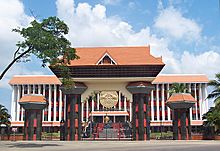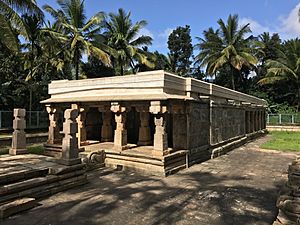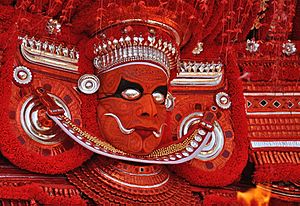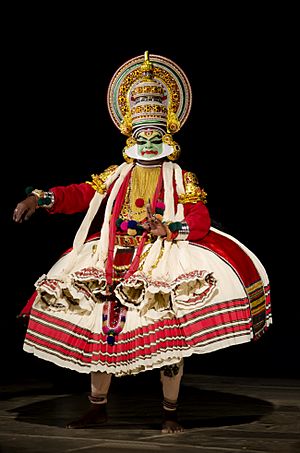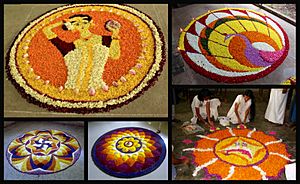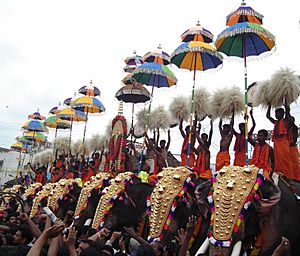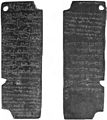Kerala facts for kids
Quick facts for kids
Kerala
|
||
|---|---|---|
|
Clockwise from top:
Niyamasabha Mandiram, Rice fields of Kuttanad, Kovalam Beach, Kathakali performer, Athirappilly Falls, Boathouse |
||
|
||
| Nickname(s):
God's Own Country, Spice Garden of India, Land of Coconuts
|
||
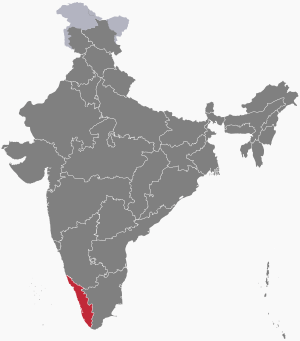
Location of Kerala
|
||
| Country | ||
| Statehood | November 1956, 1 | |
| Capital | Thiruvananthapuram | |
| Districts | 14 | |
| Government | ||
| • Body | Government of Kerala | |
| Area | ||
| • Total | 38,863 km2 (15,005 sq mi) | |
| Area rank | 22nd | |
| Highest elevation | 2,695 m (8,842 ft) | |
| Lowest elevation | −2.2 m (−7 ft) | |
| Population
(2011)
|
||
| • Total | 33,387,677 | |
| • Rank | 13th | |
| • Density | 859.112/km2 (2,225.090/sq mi) | |
| Demonym(s) | Keralite, Malayali | |
| GDP (2018–19) | ||
| • Total | ₹7.73 lakh crore (US$130 billion) | |
| • Per capita | ₹162,718 (US$2,800) | |
| Languages | ||
| • Official | Malayalam | |
| • Additional official | English | |
| Time zone | UTC+05:30 (IST) | |
| ISO 3166 code | IN-KL | |
| Vehicle registration | KL | |
| HDI (2018) | ||
| Literacy (2011) | 94% | |
| Sex ratio (2011) | 1084 ♀/1000 ♂ | |
Kerala is a beautiful state located on the southwestern coast of India. It is known for its stunning beaches, green landscapes, and unique culture. The state was formed on November 1, 1956, by bringing together regions where people spoke the Malayalam language.
Kerala covers an area of about 38,863 square kilometers (15,005 square miles). This makes it the 22nd largest state in India by size. It shares its borders with Karnataka to the north and Tamil Nadu to the east. To the west, it has the Lakshadweep Sea.
With over 33 million people (as of the 2011 Census), Kerala is the 13th most populated state in India. It is divided into 14 districts, and its capital city is Thiruvananthapuram. Malayalam is the main language spoken here and is also the official language of the state.
Contents
Kerala's Past: A Brief History
The Chera Dynasty was one of the first important kingdoms in Kerala. Other kingdoms like the Ay kingdom in the south and the Ezhimala kingdom in the north also existed long ago. Kerala has been famous for exporting spices since as early as 3000 BCE.
In the 15th century, traders from Portugal came to Kerala looking for spices. This led to European countries starting to take control of parts of India.
When India was fighting for its independence in the early 1900s, Kerala had two main princely states: Travancore and the Kingdom of Cochin. These two states joined together in 1949 to form the state of Thiru-Kochi. The northern part of Kerala, called the Malabar region, was part of British India's Madras province. After India became independent, this region joined the new state of Madras. Finally, in 1956, all these Malayalam-speaking areas came together to form the state of Kerala.
Kerala's Economy: How People Make a Living
Kerala's economy is the 12th largest among Indian states. Growing crops like pepper and natural rubber is very important here. These crops contribute a lot to India's total production. Other key farm products include coconuts, tea, coffee, cashew nuts, and various spices.
Many people in Kerala work in traditional industries. These include making items from coir (coconut fiber), handloom fabrics, and handicrafts. About one million people are employed in these sectors.
The state also has a mining industry that digs up minerals like ilmenite, kaolin, bauxite, and silica. Beyond these, manufacturing and home gardens are also important. Kerala is also focusing on growing its Information Technology (IT) sector.
Tourism is a big part of Kerala's economy. Many people visit for its beautiful backwaters, cool hill stations, sunny beaches, and Ayurvedic tourism (traditional healing). The state's lush green tropical scenery is a major draw.
Kerala's Rich Culture
Kerala's culture is a mix of different influences, making it very diverse. It's a blend of ancient Aryan and Dravidian traditions. Over centuries, contact with other cultures from nearby places and overseas has shaped it. Kerala's unique location has also helped develop its special lifestyle, art, buildings, language, literature, and social customs.
More than 10,000 festivals are celebrated in Kerala every year! The Malayalam calendar, which started in 825 CE, is still used to plan farming and religious events.
Festivals and Celebrations
Many temples in Kerala hold special festivals on certain days each year. A common tradition is raising a holy flag at the start of the festival and taking it down on the last day.
Some of the most famous festivals are called Poorams. The Thrissur Pooram is the best known. It features decorated elephants, amazing firework displays, and huge crowds.
Local festivals, known as utsavams, are held annually by many temples. If a temple can afford it, they will often include at least one beautifully decorated elephant in the celebrations. The temple's idol is carried on a procession around the area on top of this elephant. People often offer rice, coconuts, and other gifts when the procession visits their homes. These parades often include traditional music like Panchari melam or Panchavadyam.
Onam: A Harvest Festival
Onam is a major harvest festival celebrated by the people of Kerala. It reminds everyone of the state's farming past. It's a local festival that includes four days of public holidays.
Onam happens in the Malayalam month of Chingam (around August–September). It celebrates the story of Vamana, an avatar of the Hindu god Vishnu, and the return of King Mahabali, a devotee of Lord Vishnu. The Onam festival lasts for 10 days and is celebrated all over Kerala with many cultural activities.
Music and Arts
Classical music in Kerala has been greatly influenced by the traditional performing arts linked to temple culture. The unique classical music style called Sopana Sangeetham shows how much temple traditions have added to Kerala's arts. Carnatic music is also very popular in Kerala's traditional music.
Kerala's visual arts range from traditional murals (wall paintings) to the works of Raja Ravi Varma, the state's most famous painter. Kerala is also home to many performance arts. These include five classical dance forms that started and grew in temple theaters with support from royal families.
Delicious Kerala Cuisine
Kerala cuisine offers many vegetarian and non-vegetarian dishes. These often use fish, chicken, and other meats. Spices have been grown in Kerala for thousands of years and give its food a special flavor.
Rice is a main food eaten throughout the day. Most breakfast foods in Kerala are made from rice in some form. These might be served with chutney, kadala (chickpea curry), payasam (a sweet pudding), payar pappadam (mung bean curry with crispy flatbread), appam (pancakes), chicken curry, beef fry, egg masala, and fish curry.
Lunch usually includes rice and curry with dishes like rasam, pulisherry, and sambar. A Sadhya is a special vegetarian meal served on a banana leaf, often followed by a cup of payasam. Popular snacks include banana chips, yam crisps, tapioca chips, unniyappam, and kuzhalappam. Seafood favorites include karimeen (pearl spot fish), prawns, shrimp, and other shellfish dishes.
Wildlife and Nature in Kerala
Elephants are a very important part of Kerala's culture. Almost all local festivals in the state include at least one beautifully decorated elephant. Kerala has the largest number of domesticated elephants in India, about 700 of them. These Indian elephants are owned by temples and individuals. They are mainly used for processions and displays during festivals.
While over 10,000 festivals are celebrated each year, some animal lovers have expressed concerns about elephants being overworked during these events. In Malayalam literature, elephants are sometimes called the "sons of the sahya" mountains. The elephant is the state animal of Kerala and is even shown on the emblem of the Government of Kerala.
Most of Kerala's amazing biodiversity (variety of life) is found and protected in the Western Ghats mountain range. Up until the 18th century, three-quarters of Kerala's land was covered in thick forests. As of 2004, over 25% of India's 15,000 plant species are found in Kerala. Out of 4,000 flowering plant species, 900 are used for medicine, and 159 are threatened (at risk of disappearing).
Overall, 24% of Kerala is covered by forests. Three of the world's important Ramsar Convention wetlands—Sasthamkotta Lake, Ashtamudi Lake, and the Vembanad-Kol wetlands—are in Kerala. Also, a large part of the Nilgiri Biosphere Reserve is here.
In the 20th century, many forests were cleared for farming. However, much of the remaining forest is now protected from clearfelling (cutting down all trees). The eastern mountains of Kerala, which face the wind, have tropical moist forests and tropical dry forests. These are common in the Western Ghats. The world's oldest teak plantation, 'Conolly's Plot', is located in Nilambur.
Kerala's animals are known for their variety. The state is home to 118 species of mammals, 500 species of birds, 189 species of freshwater fish, 173 species of reptiles, and 151 species of amphibians. Sadly, these animals are threatened by habitat destruction, soil erosion, landslides, and other environmental issues.
Images for kids
-
Indian giant squirrel, Silent Valley National Park
-
Portrait of Parashurama by Raja Ravi Varma relating to Keralolpathi.
-
Poovar is often identified with Biblical Ophir
-
Portrait of the sword of Zamorins of Kozhikode, relating to the legend of Cheraman Perumal.
-
Ancient Silk Road map showing the then trade routes. The spice trade was mainly along the water routes (blue).
-
Quilon Syrian copper plates granted to Saint Thomas Christians by Venad (Kollam) ruler Sthanu Ravi Varma, testified about merchant guilds and trade corporations in Early Medieval Kerala. The sixth plate also contains a number of signatures of the witnesses to the grant in Arabic (Kufic script), Middle Persian (cursive Pahlavi script) and Judeo-Persian (standard square Hebrew script).
-
A panorama of port Kozhikode, shows several types of ships, shipbuilding, net fishing, dinghy traffic and a rugged, sparsely populated interior (Georg Braun and Frans Hogenberg's atlas Civitates orbis terrarum, 1572)
-
Uru, a type of ship that was historically used for maritime trade, built at Beypore, Kozhikode
-
The path Vasco da Gama took to reach Kozhikode (black line) in 1498, which was also the discovery of a sea route from Europe to India, and eventually paved way for the European colonisation of Indian subcontinent.
-
Bolgatty Palace, built in 1744 by Dutch Malabar, also acted as the British Residency in Kochi
-
The Mattancherry Palace at Kochi was built and gifted by the Portuguese as a present to the Kingdom of Cochin around 1545
-
Bekal Fort at Kasaragod built in 1650 CE, the largest fort in Kerala
-
British Residency in Asramam, Kollam
-
Kanakakkunnu Palace at Thiruvananthapuram. Thiruvananthapuram became a major city on Malabar Coast after the ruler Marthanda Varma annexed all minor kingdoms up to Cochin to form Travancore in 18th century CE.
-
Kerala in British India (1909). Thiruvananthapuram, Kozhikode, Kochi, and Kannur, were the major cities of the state at that time as indicated in the map
-
Jackfruits are the state fruit, and are a cultural icon of Kerala.
-
A paddy field at Palakkad, also known as The Granary of Kerala
-
Black pepper is an important cash crop in Kerala, which leads the country in production.
-
A panoramic view of Vyttila Mobility Hub integrated transit terminal in the city of Kochi
-
KSRTC Bus Station at Kozhikode
-
The Population pyramid of Kerala
-
Participants at a pride parade in Thrissur in October 2018
-
Malayala Manorama office in Kottiyam, Kollam
-
The annual snake boat race is performed during Onam on the Pamba River
-
Greenfield International Stadium in Thiruvananthapuram.
-
Jawaharlal Nehru Stadium in Kochi.
See also
 In Spanish: Kerala para niños
In Spanish: Kerala para niños


